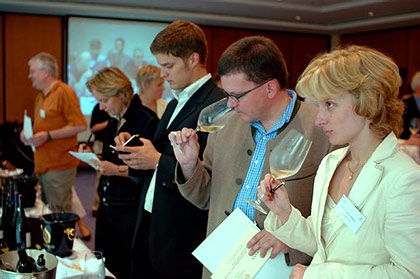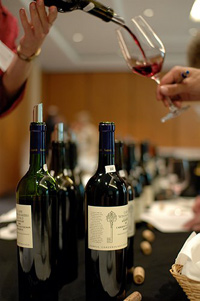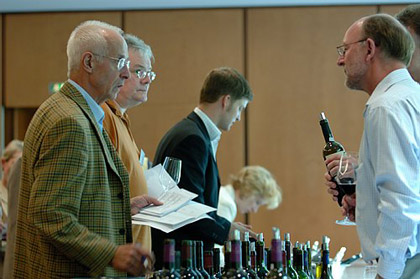Germany premiere: South Africa's Cape Winemakers Guild gave an impressive sample of its quality orientation.
Tastings are not infrequently influenced by location and ambience; salons and upmarket interiors not only emphasise the quality of the wines being tasted, they occasionally also highlight the quality and elegance of the wines. At the tasting of the "Masterpieces" of the South African Cape Winemakers Guild in the Grandhotel Nassauer Hof in Wiesbaden, which took place for the first time in Germany, it was almost the other way round: the outstanding quality of the wines presented harmonised "as a matter of course" with the tasting venue and underlined its self-image, which includes a quality consciousness that is as unpretentious as it is extraordinary.
It was this quality consciousness that prompted eight independent cellar masters to found an association with a passionate vision in 1985: while South Africa was still excluded from most foreign markets in the 1980s due to the anti-apartheid sanctions, the cultivation of "benchmark wines" was intended to raise the standard of South African wines and gradually promote their reputation at home and abroad. Over the years, the illustrious circle was expanded to include successful winemakers from estates such as Vergelegen and Beyerskloof, Glen Carlou and Jordan Winery, Thelema and Simonsig.

|
| Association with a passionate vision - Cape Winemakers Guild |
The Winemakers Guild, which today has 37 members, has an extremely strict admission procedure: A new member can only be nominated through a personal recommendation by an already active member and accepted by a two-thirds majority. The decisive prerequisite for a nomination, however, is that the winemaker invited to membership - not the winery! - has already been responsible for producing outstanding wines for at least five years.
The highlight of the annual calendar of the "South African VDP" (according to Cape Wine Master Peter Gebler), which has been supported by the local Nedbank for eleven years now, is the "Nedbank CWG Guild Auction Of Rare Cape Wines" in Somerset West (Western Cape) at the beginning of October. Local and international traders, restaurateurs and private wine collectors from all over the world bid for the exclusive Guild wines, which have been specially vinified for the auction and are clearly different in style from the actual winery lines: Emphasis is placed on highest quality and typicity, but above all on high ageing and aging potential. Barely four weeks before the auction date on 7 October, a larger selection of mature vintages, but also of the current auction wines, could now be tasted in Wiesbaden (organised by www.suedafrika-wein.de).
"Class instead of mass" as a strict principle
The problematic relationship between quality and quantity in wine production was demonstrated here in an extremely instructive manner. The quality of Guild wines can obviously only come from a harvest that is subject to radical yield restriction. A comparison with certified German top wines, whose permitted yield is significantly higher than that for Guild wines, shows how consistently the South African cellar masters involved and the estates they represent have committed themselves to the quality requirement: While for German selection wines from delimited single vineyards the permitted yields are a maximum of 60 hl/ha and for the Grosse Gewächsen from the "Erste Lagen" of the VDP classification (delimited parcels of the highest quality terroirs) only 50 hl/ha may be achieved, the auction wines are vinified from only 20 to 40 hl/ha (!) of must. With this unconditional commitment to the maxim "class instead of mass", it is conceivable to what extent the flagships of the Cape Winemakers Guild are characterised by aromatic diversity and richness of body.

|
| Class instead of mass - characterised by aroma diversity and body richness |
So it is not surprising that the masterpieces of these renowned winemakers are also found in the top ranks of the annual evaluation of the authoritative South African wine guide "Platter". For the 2007 edition, which will be published in November (see also Wein-Plus-News of 22.08.06), it was already reported in advance that out of a total of 6,000 South African wines selected in a lengthy procedure, 25 top products were awarded the most coveted of all awards - 5 stars for the "top performers". Two things are remarkable about this: Never before has the number of top-awarded wines been so high. And: 14 of these top products alone come from "CWG" members.
Guild Auction Wines as South Africa's Benchmark Wines
Among the white wines of the Cape Winemakers presented at the German premiere, a common trait that stood out was the pronounced freshness and fruitiness in combination with intense aroma tableaux. This was especially true for the Nitida Selection Sauvignon Blanc 2006 with fresh acidity and strong notes of pepper, honey and lime blossom as well as - even more concentrated - for a Semillon-Sauvignon blend Weather Girl 2006 by Flagstone with high minerality from slate and flint, but also with notes of paprika and smoke. Probably the highlight was a Hartenberg Dry Weisser Riesling (Auction Reserve 2005), whose aroma perception of Golden Delicious and ripe peaches, of green pepper, flint and botrytis-related honey tone did not want to end and whose melting and stimulating acidity did not necessarily facilitate the tasting transition to the red wines.

|
| High-quality red wines throughout and never ponderous |
A South African quality concept as a European challenge
The German premiere of the Cape Winemakers Guild made it clear that its quality concept - rewarding years of top production by individual cellar masters - surpasses and personalises the "European" model of quality orientation. The most important models of classification - above all Burgundy with its strong link to terroir and Bordeaux with its interweaving of terroir and long-standing successful producers - do not identify rank and quality with chronologically defined individual achievements of responsible winemakers and cellar masters, but with the almost supra-temporal criteria of place, location and former historical role. These models were and are classic examples of the emergence and cultivation of local wine myths that nevertheless have a global impact.

|
| Cape Winemakers Guild - an impressive sample |
The Cape Winemakers Guild, on the other hand, represents a different, no less elitist sense of status: it is based not only on the highest standards, but on continuously demonstrated skill. It is not satisfied with past results and a high "average level", but expects the personal member to unconditionally continue his quality work even if he changes the winery and takes on responsibility in a new position ("continue to be responsible for the production of outstanding wines"). A winery that has been represented in the Guild for many years can suddenly be "out"; another winery as the new employer of a Guild winemaker can no less suddenly be pleased about its presence in the association - and the image gain associated with it.
Since the auction wines reflect the special nature of a vintage (no alcohol reduction through "centrifugal cone columns"!), an estate's own wine culture (terroir), a ward (the smallest wine-growing zone so far) and an individual winemaker's signature (early drinkability and at the same time high storability), they prove to be South African "profile wines": they deliberately transcend the lines of the producing estates and show the qualities and the setting of "benchmarks" that the wine-growing nation of South Africa, as modern as it is rich in tradition, is capable of.
Further links:
www.capewinemakersguild.com
www.platteronline.com
www.suedafrika-wein.de